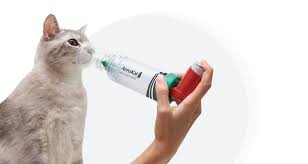
Feline chronic small airway disease comprises a spectrum of conditions involving the small airways (bronchioles) within the lungs. The condition is also known as chronic bronchitis, allergic airway disease, allergic bronchitis and asthma.
Some cases bear similarities to asthma in humans, hence it is frequently known as 'feline asthma', however the majority of cases are not proven to have an allergic cause. Inhalation of irritants such as pollens, cigarette smoke, dust and household cleaning sprays are sometimes implicated.
The airways respond to an irritant by contraction of the bronchial smooth muscle in order to prevent the irritant from moving deeper into the lung, the production of mucus to trap the irritant and initiation of a cough to expel the irritant. Contraction of the smooth muscle, mucus production and airway inflammation all contribute to narrowing of the airways which results in difficulty breathing.
Cats of any age, breed or sex can develop chronic airway disease, however young to middle aged cats are most frequently affected. Siamese and Burmese cats appear to be particularly predisposed.
Signs vary from chronic coughing and/or wheezing to the development of sudden onset laboured breathing without any prior clinical signs. An increase in respiratory rate (>30-40 breaths per minute) or effort (particularly expiratory effort - breathing out) may also be noticed. Symptoms may come and go or may be so mild that they go unnoticed by owners for sometime.
Other diseases such as bacterial infections, foreign bodies, heart disease, airway parasites and lung cancer can present with similar clinical signs and therefore these need to be eliminated before a diagnosis of chronic small airway disease can be made.
X-rays of the chest are required and usually demonstrate evidence of thickening of the bronchial (small airways) walls and air trapping within the airways. Air trapping occurs because when the airways have constricted, air cannot be exhaled. The lungs therefore appear larger than normal on X-rays, as they are over-inflated. The diaphragm may seem flattened due to this over-inflation. Not all cats however will have these changes, and X-rays can appear normal.
Another diagnostic technique that can be useful is bronchoscopy. This is a technique whereby an endoscope is passed into the airways to enable visualisation of the airways. Excessive mucus, roughening and reddening of the airways may be seen in cats with chronic airway disease, although again the gross appearance can be normal in some cats. Very small endoscopes are required to examine the airways of cats and therefore this procedure is most frequently carried out at specialist centres.
Airway washes (bronchoalveolar lavage or BAL) can also be collected and examined under a microscope for the presence of inflammatory cells, bacteria and cancer cells. These washes can also be cultured to assess whether bacteria are present within the lungs. Lots of inflammatory cells are usually evident in washes taken from cats with chronic small airway disease.
1. Anti-inflammatories - Reducing the inflammation within the airways is the most important part of treatment. Corticosteroids are potent anti-inflammatories that are used to achieve this. This treatment can be administered in different ways:

2. Bronchodilators - Drugs to help dilate the airways are usually used in conjunction with corticosteroids. These can also be given in the form of oral or injectable medication or by inhalational treatment.
3. Mucolytics - In some cats excessive production of mucus can be a problem. Adding a mucolytic (eg. Mucodeine) can help in these cases.
4. Reducing exposure to irritants - Some actions can be taken in the home to reduce the severity of the signs, namely avoidance of smoking and the use of household sprays around the cat. Using a low dust type of litter may also help.
The prognosis for this condition depends on the severity of the disease and on the time delay before treatment is initiated. Whilst the majority of cats respond well to treatment, acute severe attacks can prove fatal if treatment is not initiated promptly. In addition, if the condition is chronic and treatment has been delayed, irreversible fibrotic changes within the airways can occur.